The Concert
c. 1663–1666Oil on canvas
72.5 x 64.7 cm. (28 1/2 x 25 1/2 in.)
Isabella Stewart Gardner Museum, Boston (stolen)
The Concert and The Music Lesson are two paintings that point out the difficulties of interpreting precisely the meanings of Vermeer's works. The theme of music is a frequent one in Dutch art and is generally associated with love and seduction. Paintings by Steen (fig. 1), Van Mieris, and Metsu often include a small statue of Cupid surmounting a door or mantelpiece as a reference to the underlying emotional context of the scene. Associations with love and seduction are also evident in the general attitudes or the figures in these paintings. The music instructor frequently appears more than professionally interested in his student and her progress as a musician.
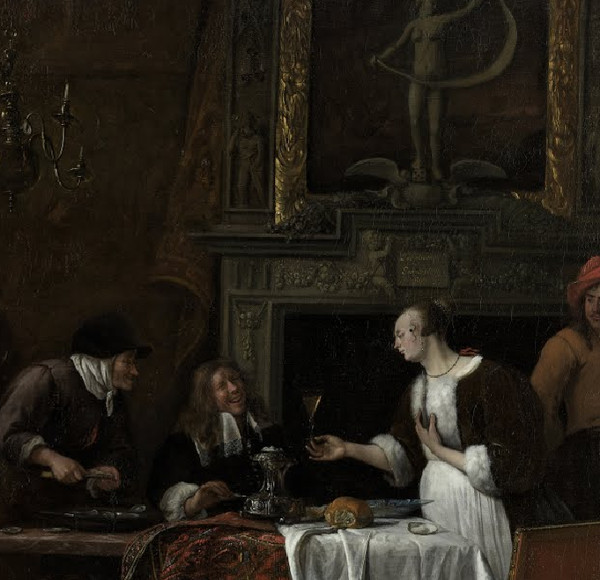
Jan Steen
1660
Oil on canvas, 102.8 x 133.9 cm.
Museum Boijmans Van Beuningen, Rotterdam
Vermeer, however, did not provide such clear meanings for his paintings. His choices of objects offered tantalizing suggestions, but the attitudes of his figures remain surprisingly neutral. In the background on the right of The Concert, for example, hangs The Procuress by Baburen. The subject of this scene has often been thought to indicate the nature of the relationship of the three figures involved in the concert before it. These figures, however, are earnestly concentrating on their music, and do not, in themselves, reinforce the licentious nature of the scene portrayed on the wall.
If we assume that Vermeer intentionally placed The Procuress and the landscape to its left on the wall, how are we to interpret this scene? One solution could be that the figures were meant to be in contrast to the paintings rather than to represent, as it were, a tableau vivant, music was also used as a symbol for harmony and as a salve for the soul. With such an interpretation, we note also that the landscape on the clavecin is peaceful and Arcadian whereas that on the wall is rugged, in the manner of Jacob van Ruisdael. It includes a dead tree trunk, a motif Ruisdael was fond of using to indicate death and decay.
In this sense the theme of The Concert parallels that of The Music Lesson (fig. 2) more closely than one might expect. One may rightly question the appropriateness of the title of The Music Lesson. The gentleman, who is very properly dressed, seems more intent on listening than on instructing. No written music is evident in the formal and spacious interior. As in The Concert, the theme seems to be the mollifying effects of music on the human soul. On the cover of the clavecin is written: Musica Letitiae C()[me]s Medicina Dolor[um] (Music: Companion of Joy, Balm for Sorrow). By placing the girl so that her back is to us, Vermeer effectively underplayed the importance of her personality and of any relationship between her and the man, allowing us to ponder the significance of music in our lives.

Johannes Vermeer
c. 1662–1665
Oil on canvas, 73.3 x 64.5 cm.
The Royal Collection, The Windsor Castle
The similarities between The Concert and The Music Lesson are such that they have often been dated at the same time. Both the conception of the scene and the painting techniques of The Concert, however, place it around 1665–1666, sometime after the conception of The Music Lesson. The mood of The Concert is more relaxed than that of The Music Lesson. The figures seem to belong naturally to the room and to participate in the rhythm of the music. The case in their demeanor probably resulted from Vermeer's experiences in depicting the series of single figures during the years 1662 to 1665.
The evolution of Vermeer's painting techniques parallels this advance in conception. In The Music Lesson he attempted to simulate a number of specific textures by varying the ways he applied his paints: the table covering had a rough, woven appearance; the tassels on the chair cover were indicated with thick paint to enhance their three-dimensional effect. These interests are no longer apparent in The Concert. The table covering now has a relatively abstract character. Although the pattern is still defined and small highlights flicker from its surface, one does not sense the same interest in rendering the appearance of woven wool that was previously apparent.
The ways in which the women's yellow jackets are painted are also strikingly different in the two paintings. In The Music Lesson the paint is densely applied (fig. 4). Shadows are almost totally created by a thin glaze that covers this opaque layer. In The Concert the colors of the dress are painted more sparingly (fig. 3). Shadows, particularly in the skirt, are formed with the ground color rather than with glazes over opaque yellows. The effect of the painting is softer and more delicate than that of The Music Lesson.
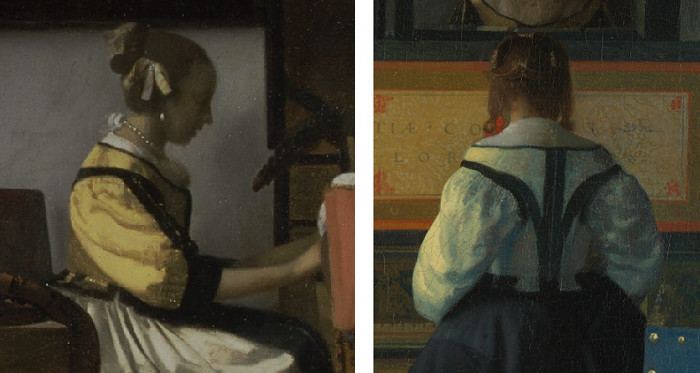
Johannes Vermeer
c. 1663–1666
Oil on canvas, 72.5 x 64.7 cm.
Isabella Stewart Gardner Museum, Boston
Fig. 4 (right) The Music Lesson (detail)
Johannes Vermeer
c. 1662–1665
Oil on canvas, 73.3 x 64.5 cm.
The Royal Collection
Unfortunately, this change to a more delicate technique created serious problems of physical condition. Some paintings from the mid-1660s, including The Concert and the Woman with a Lute, have suffered from abrasion. Perhaps Vermeer recognized this potential problem, for he painted in this manner for only a short while. In his later works his style became crisper and his paint denser; he depended less extensively on glazes and transparent effects to create his images than he did in The Concert.
The Boston Concert and The Music Lesson are almost identical in size but while The Music Lesson could be item 6 in the 1696 sale, "A young lady playing a clavecin in a room, with a gentleman listening," the Boston painting is first recorded in 1780. Their size apart, the two works have a number of features in common but the most distinctive is the remoteness of the viewer from the activity within the depths of the interior. In this respect they are in sharp contrast with the Frick Soldier and Laughing Girl.
The music makers in the Boston painting are not so very distant physically. But the heavy, carpet-covered table and the double-bass beside it on the floor appear as obstacles to a ready approach and a screen for the reticent observer. This is most striking where the table-top, loaded with obscurely foreshortened but almost accessible carpet and violin, is juxtaposed with the profile of the player at the clavecin, thus emphasizing her small scale and, thereby, her remoteness.
As befits a representation of music-making, the painting is a miracle of measure and harmony. The bold quadrilaterals of the ebony frames on the rear wall are set against the complex perspective transformations of the far smaller but similarly rectangular floor tiles, and within this grand theme a multiplicity of rhymes and contrasts is established. The vertical of the clavecin lid continues the line of the landscape's frame and so creates a frame for the cameo profile of its player, while the sweep of its other edge modulates the relation of singer to the other painting. The black edging on the clavecin player's robes not only completes the framing of her profile but also links the unmodified rectangularity of the clavecin frame with the man's sword and thus with the perspective of the tiling. At the heart of the painting is the glowing, golden-orange lozenge that is the back of the cithern-player's chair and which dominates a further set of rhythms: between this chair back and that of the more distant, shadowed back of the clavecin player's chair, linked as they are by the black edging on the woman's skirt; and with the man's shoulder-belt, so closely related in proximity, colour and form and with the complex foreshortening of the chair's own legs and cross-bars in their relations with the diapering of the floor-tiles. Such relationships are at once absorbing and inexhaustible, it seems.
If the painting may in this way be said to exemplify visually the nature of the musical harmony it represents, what of the significance to this sense of harmony of the quiet unharmonious painting on the wall to the right, which is that painting of a Procuress (fig. 5) by Dirck van Baburen. This, too, contains three characters, a gallant and two women. And it is notable that Vermeer has left his cithern player rather improbably wearing his identifying shoulder-belt and sword (although his plumed hat is not in sight). But his back is turned, his face bidden. All that is offered is a play, a counter-point, between the bawdry of the painting on the wall and the apparently chaste harmonies created by the trio within the room.
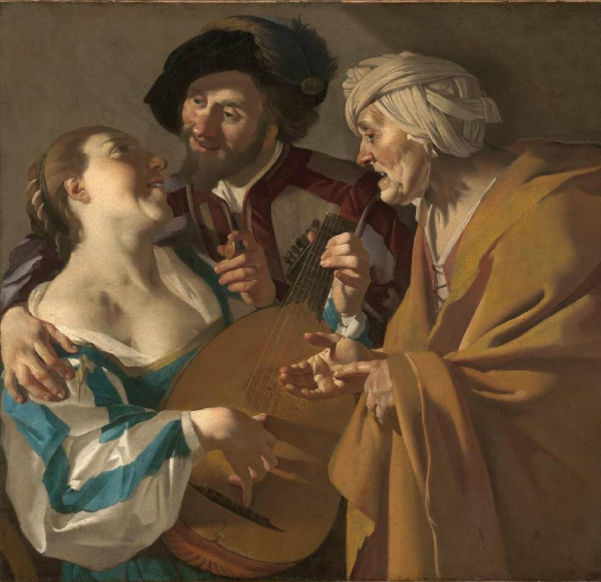
Dirk van Baburen
1622
Oil on canvas, 101.6 x 107.6 cm.
Museum of Fine Arts, Boston

Elise Goodman
"The Landscapes on the Wall in Vermeer"The Cambridge Companion to Vermeer (Cambridge Companions to the History of Art)
2001, pp. 74–75
Vermeer's prominent characters represent the kind of people who would have known the musical lyrics through Dutch, French, and even English song-books and part-music. The performers who appear in the paintings are members of the haute bourgeoisie, people who read, wrote, and often spoke several languages and who collected European poetry in which the latest love conventions appeared. Although we know nothing about the specific ways in which Vermeer himself was stimulated, since we have no information about his literary and musical predilections, the enframed landscapes (and inset emblematic figural paintings) show that he was sensitive to what was in his air. Many of the topoi to which he alludes also occur in multilingual expository verses appended to the amatory emblems with which he must have been familiar. His paintings in general betray a knowledge of musical instruments and point to his interest in and fascination with the musical scene of his day.
Amateur musicians of the kind depicted in many of Vermeer's paintings collected these. For example, Gesina ter Borch (fig. 6), the sister of the famous genre painter Gerard (fig. 7), whom Vermeer knew, owned at least one book of keyboard music (c. 1661) with several French tunes. (Other Dutch songbooks that featured the gezelschapslied (a social lyric set to musical accompaniment) contained French, and to a lesser degree, English and Italian pieces. The most popular songbooks in Holland were filled with French love lyrics, and the Dutch burghers took to them with a passion.
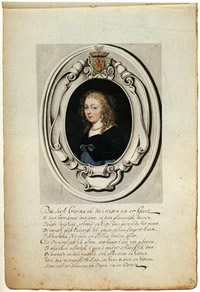
Gesina ter Borch
1660
Watercolor on paper, 31 x 20 cm.
Rijksmuseum, Amsterdam
Underneath the portrait a friend wrote a poem praising her virtue, wisdom, beauty and honor.
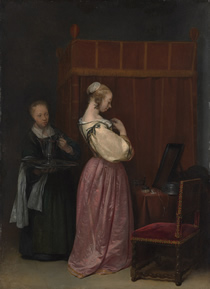
Her Toilet with Her Maid
c. 1650–1651
Oil on panel, 47.6 x 34.6 cm.
Metropolitan Museum of Art, New York
The ultimate inspiration for Dutch lyrics, and for European love poetry in general, came of course from Petrarch. Dutch poets were deeply influenced by Petrarchan conventions of nature and love, which reached them via the French Pléiade (a prominent group of sixteenth-century French poets) and their contemporaries. The better-known Dutch writers such as Pieter Cornelisz. Hooft, Constantijn Huygens, Daniel Heinsius, and Joost van den Vondel were nourished in France on Petrarch, Pierre de Ronsard (1524–1585), Joachim du Bellay (c. 1525–1560), and Philippe Desportes (1546–1606). Huygens (1596–1687), a talented composer of songs as well as lyric poems, imported to his native country some of the latest French Petrarchan airs for musical accompaniment on the lute and harpsichord. And nonprofessional Dutch poets and amateur musicians sometimes composed their own Petrarchan-style lyrics in French.

Elise Goodman
"The Landscapes on the Wall in Vermeer"The Cambridge Companion to Vermeer (Cambridge Companions to the History of Art)
2001, p. 88
During Vermeer's time composers frequently opposed somber landscapes to the gentle beauty of their ladies. Thus Pieter Corneliszoon Hooft's "Natuur, die daar schijnt in droeve damp begraven" (Nature, which seems to be buried in a sad cloud over there) entones the difference between dismal nature and the glow of a beautiful woman who gave it its richest gifts. Further, Jean Boyer's air "Sombres forests, noires vallées" (Somber forests, dark valleys; 1621) in a similar tenor asserts that "This sun whom I love so well, / Has so much beauty and grace, / Than [that which is] absent from your divine face" [that is, from the landscape]. In other lyrics, the lady's presence "can civilize the rudest place" and imparts order and beauty to nature. Reversely, love poets and composers were wont to compare their ladies' hardness and lack of feeling to the woods and craggy rocks.
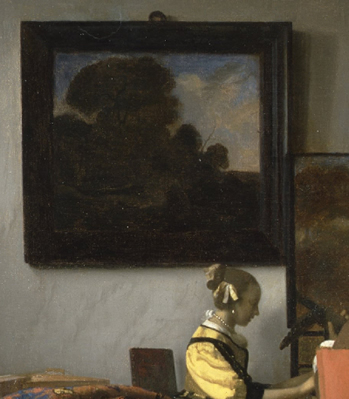
Johannes Vermeer
c. 1663–1666
Oil on canvas, 72.5 x 64.7 cm.
Isabella Stewart Gardner Museum, Boston
Altogether, the modes of the inset landscapes and their placement in The Concert may be taken to indicate the cavalier's honorable intentions and the decorous character of the harpsichordist next to him; its subject, I believe, is domesticized, civilized, and civilizing love.
Vermeer's enframed pictures of nature (fig. 8), as I have argued, should be paralleled and compared with musical pieces about landscapes that his performers may be thought to be playing. The insets furnish some clues to the general meaning of the paintings themselves and they help us to better understand their themes of love and beauty. Like the versifiers and composers of the seventeenth century, Vermeer uses landscapes anthropocentrically and gives them social and amorous overtones. As in period songs and lyrics, nature is conventionalized and reconstituted in a closed room and is brought into rapport with good society, ringing variations on courtship and love. Macrocosmic nature does not contain human nature; rather, the desires and emotions of the human microcosm create the macrocosmic evocations within the enframed works of art. Vermeer varied and modulated his landscapes on the walls in his paintings to suit the nature and mood of the human drama he portrayed in the foreground.

